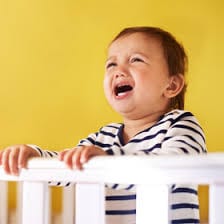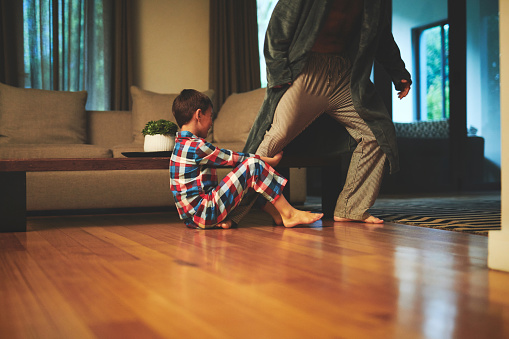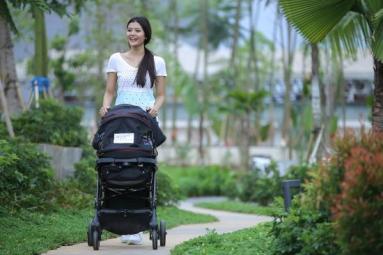
What is separation anxiety in babies? While my baby was 7 months old, I tried leaving him in his crib to go to get some water from the dispenser. However, my child cried hysterically until I had to come back. This was a new thing since before then I could leave my child with minimal fuss, when does separation anxiety start?
Separation anxiety upsets both parents, family, and the child. The frustration boils from having fears in children and also since the child looks upset makes the parents get stressed. The worry as a parent is when the separation anxiety will stop.
Separation anxiety is a typical stage of emotional growth in children which begins when the child commences to comprehend that people and things exist even in instances where they are not available at the time being. Object permanence is a concept used to describe the knowledge that things exist even when not available at the time being.
The separation anxiety starts to show as the child grows with signs of anxiety and being upset at being left alone by a parent.
This helps in children protection, a child’s protector leaving them will always cause anxiety. Children in the African culture rarely are left behind by their mothers but in the western culture, parents try to give their children a sense of autonomy. For example, children in the Western cultures always sleep in their own crib from an early age while in Africa and other cultures, children sleep in the parents’ bed for as long as it’s possible.
Separation anxiety always passes but it is recommended that the parent makes the situation better for the child. Separation anxiety shows the level of bond between the parent’s and the baby.
Contents
What is separation anxiety?
Separation anxiety is the anxiety a baby or young child experiences when their parents or caregivers leaves them which commonly starts at six (6) months. A child or toddler suffering from separation anxiety will be clingy, throw tantrums, or cry when separated from the caregiver for either a short time or long time.
Therefore, you will find separation anxiety and fear of strangers being common in young children between the ages of 6 months and 3 years with the peak being between 10 and 18 months. Most of the children outgrow the anxiety since it is a normal part of your child’s development.
Separation anxiety is a very common condition in babies and young children with most children having tearful, tantrum-filled goodbyes. It occurs when a child becomes anxious or stressed about being separated from their caregiver. This may happen as often as once or twice per week, depending on the age of the child and their level of comfort with separations.
What is separation anxiety in babies?
What is separation anxiety in babies? When a baby or young child experiences anxiety when their caregiver leaves them for work or at daycare, it’s called separation anxiety. Most babies experience some degree of separation anxiety but the levels vary from mild to severe.
Mild levels of anxiety may be characterized by fussing and crying when their caregivers leave the room, while severe cases are characterized by wrenching away from caregivers, constant screaming and refusal to go with their caregiver.
When does separation anxiety start?

In some children, separation anxiety starts as early as 6 or 7 months. At this stage, the child will start being upset and anxious about being separated from the parents. The peak for separation anxiety occurs between 10 to 18 months but starts reducing at 2 years.
For most children, anxiety is seen when the parent has to leave and go to work or do the chores. It may also be experienced when the child is left alone in the crib at night.
When does separation anxiety end? In most cases, the signs and symptoms of separation anxiety in toddlers significantly reduce at 24 months. Separation anxiety in almost all children ends at the age of 3 years.
What are the separation anxiety symptoms in Babies?
Separation anxiety is considered a milestone in the development of the child. It however comes with symptoms that cause unease both to the parents, relatives, and the baby.
Some of the most common symptoms of anxiety in children include:
- Clinging to parents or people the toddler knows
- Intense or severe crying especially when you leave them alone in the room
- Waking up frequently at night
- Being afraid of strangers thus resulting to crying when being held by unfamiliar people
- Throwing up emotional temper tantrums
To diagnose the anxiety disorder, when the child has the symptoms above and is crying, pick-up the child; If the child’s crying stops, then know that it is separation anxiety. If not check for other causes.
For children suffering from separation anxiety disorder (SepAD), a separation anxiety condition that occurs past the toddler years, the following additional symptoms are experienced:
- Being unable to interact normally with other children
- Refusal to go to school or do things that require separation
- Poor performance at school
- Physical illness including headaches and tummy problems. Some children might get diarrhea, nausea, and vomiting.
- Nightmares
- Having problems in sleeping alone
SepAD is a disorder that affects approximately 3-4 percent of all children. These children may also develop or could be having other mental disorders. A third of children with separation anxiety disorder will be diagnosed with a mental disorder in their adulthood.
Separation anxiety in adults

This is almost similar to the separation anxiety in babies. It can occur when a person is separated from a parent, a partner, a child, or a place.
In some instances, the anxiety disorder is related to other underlying mental disorders. These disorders include psychotic disorders or autism spectrum disorder-related fear of change.
For most people, separation anxiety disorder is described as being overprotective. The act of being overprotective serves as a way of expressing the anxiety.
The risk factors for separation anxiety disorders in adults include:
- Obsessive-compulsive disorder (OCD)
- Other anxiety disorders like social phobias, panic disorders, and agoraphobia among others.
- Pre-existing medical disorders like autism and psychotic disorders
- Female gender
- Trauma in your childhood due to loss of family member and abuse
- Experiencing a traumatic event like divorce and child leaving the house for boarding school.
The separation anxiety disorder in adults can be treated using the treatment methods for anxiety disorders. These methods include:
- Psychotherapy techniques such as cognitive behavioral therapy
- Medications for anxiety disorder.
- Home remedy techniques
How to help a child with separation anxiety
There are many ways to help your baby feel more secure when you have to leave them. For example, a good way to calm your little one down is to talk on the phone, Zoom, or Skype with them while you’re gone. You could also make an extra effort to do something for them before you leave, like picking up their favorite toy off the floor or giving them some extra love and cuddles.
One of the most popular methods is swaddling, which helps babies stay soothed by making it seem as though they’ve been put back in their cozy womb.
In addition, some believe that rocking a baby with a song they like can also be helpful in calming them down and making it seem as though they are being cradled. When we know that being away from what’s familiar is stressful for our little ones, these tips can be very useful in helping ease those feelings of separation anxiety (whether it’s helpful or not).
There are several ways on how to ease separation anxiety in babies. The tips and tricks enable the child to calm down and be separated from the parent. The methods can also be used for children before preschool. Ways on how to manage separation anxiety include:
- Prepare the child for separation.
The child might not say something, but they understand a lot. It is always recommended that as a parent you should always talk and engage the child.
Inform the baby on where you are going, how long you will be gone, and who will be with him/ her while you are away. This way the child is able to look ahead and know that separation is just for a moment.
If the baby will be left with a babysitter, kindly talk about the babysitter with excitement. This way the child will be
reassured about the minder. He/she might cry at first, but the anxiety symptoms will ease in severity and frequency with time.
2. Always say goodbye as you leave:

As a parent I have sneaked-out on my baby several times during periods of extreme symptoms of separation anxiety. This was done to ensure that the child does not cry as I watch.
However, as I came to realize, this made the next separation even more extreme. In addition, after sneaking out once or twice from my baby, He realized that I may leave at any time thus being more alert. He could cry even if I left the baby and moved a few steps away.
Therefore, it is recommended that you give your child time to digest and sometimes cry when you are leaving by saying goodbye.
After some time, the child will learn that you always come back and get used to separation.
For separation anxiety in toddlers at night, it is also good to say goodbye as you leave them in their crib.
This way the child after some time will get used to the idea that they can be independent at night. Sneaking out on the baby while he/she sleeps makes the child terrified or surprised when they wake up.
The goodbye should be done without fanfare. That way the child is able to deal with the feelings as fast as possible instead of increasing the anxiety with fanfare.
When a child is faced with the moments of anxiety, he/she will scroll for any doubt and fear in either parent or with you and exploit it.
With consistent decisions from you or your partner, the child learns that separation will only last a moment. As much as possible try not to give in to their demands.
The idea should be reinforced the following day and with each passing time the child learns to respect the decisions you have made.
The same applies for separation anxiety at preschool, consistent parents will drop the child at school or to the bus, and give a short goodbye.
No matter the tantrums or crying ensure that that is the routine every day. With each passing day the child gets used to the routine and reduce the anxiety caused reactions
3. Prepare a comfort object:

The child needs a reminder of the things he is comfortable with. The best way to make sure that the child remembers the things that make him/her comfortable or happy is to give him an object as a reminder.
The transition object might include a photograph, an old sweater, a sticker, or a favorite toy. The object gives comfort and relief from anxiety symptoms.
The object may also be a source of anxiety if it reminds the child that you are not around. It therefore should be
monitored for a few times if it is working.
An object that offers security might also help such as a blanket, a stuffed animal, or sucking his finger might also help.
Also in case of a change in surroundings or caregiver, try to ensure the child has a familiar comfort object.
Some of the best anxiety toys can be found on Amazon here.
4. Set up smooth and steady changeovers:
The smooth and steady transition is an important way to ensure the child is ready for separation. To prepare for the transition, request the minder to arrive earlier than required, for example 30 minutes earlier.
For the transition period (30 minutes), let the babysitter and the child interact while you offer security and calm to the child nearby.
The changeover can also happen even during a two-day period, like a weekend, if the babysitter will be taking care of the baby for some time.
As soon as the baby is happy to stay with the minder, withdraw to the background. With time the child will get used to the babysitter. From that moment the separation anxiety will reduce.
It is also better if you maintain a consistent caregiver. This gives the baby some form of consistency that helps
to calm the baby when separation occurs.
5. Leave the house simultaneously with the baby:

If the baby is the one going out of the house, the goodbye is easier. To ensure that the baby calms down during the
separation period, ask the minder to take the baby out.
The baby and the minder can go for a stroll simultaneously as you are leaving.
Even if the child leaves the house before you, please explain to him/her that you are leaving too.
This way the child remains calm even if they don’t find you in the house. Leaving without informing the baby can cause extreme separation anxiety symptoms.
6. Ensure the baby is active as you head out:
In order to make the separation less traumatizing, ensure the babysitter and the baby are engaged in an activity
before heading for the door.
Separation anxiety as explained above peaks between 10- 18 months, at this time the baby can get involved in an activity. As you are leaving, ensure that you say goodbye.
The distraction from the activity will help to ease the anxiety reaction and saying goodbye ensures that they don’t recur once he/she notices you are not in the house.
7. Help the child to name the feeling:
Playing “name the feeling” helps the baby to communicate their worries. Naming their feelings might help to cool down the anxiety symptoms.
To play the game, ask the child to put a label in what he/she is feeling. The game enables the child to learn that
everyone suffers from similar feelings during separation.
The activity helps the child to learn and try to cope with any feeling just as the parent is coping.
8. Leave the child to acquire coping skills for separation anxiety:
A child learns through several ways. Some cultures let the child to touch a flame in order to learn that fire is
dangerous.
For anxiety, even though it is uneasy to see your child crying from separation, it might be the right thing for him to learn how to cope with the feeling.
Therefore, it may be good for the baby just to let him be. This way with time the child learns how to cope with anxiety. In some situations, a child can be too clingy, always giving in to his demands may make the anxiety worse. Let the child cry but also reassure him that he is secure, and everything is okay.
9. Schedule separations after taking food or a nap:
Separation anxieties in babies increase if he is hungry or sleepy. The mixture of feelings may be too hard on your baby.
For this reason, ensure the child is full and is not sleepy before heading out.
10. Ensure that you keep your promises:
A child will remember any promises given to him. If these promises are not kept, the child start losing confidence in your word and actions.
To ensure the baby is comfortable and less anxious the next time you leave, kindly keep your promises. These promises may even be about the time you are coming back or a gift you were to bring.
11. Ensure that there is minimal scary TV or shows on a tablet, phone or laptop that the baby can see:
If the child has seen frightening shows, he is likely to be very scary during separations. The shows might still be
lingering in his brain as you separate bringing out the extremes of separation anxiety.
Other tips for helping your baby cope with separation anxiety
There are a few ways to help your baby with separation anxiety. One is by using the 5 S’s approach:
- Swaddle the baby in a blanket,
- Sing to the baby,
- Stroke their back and head,
- Hold them safely in your arms or lap and
- Sit near a source of warmth so that they can hear your heartbeat.
Another technique is to practice self-soothing:
- Tranquil environments like gentle breezes and soft music,
- Feeding when hungry or thirsty,
- Putting on a favorite outfit or toy,
- Trying to get comfortable in a crib or car seat before leaving their caregiver and
- Playing with toys while waiting for their caregiver.
You can also try some distraction techniques:
- Watching flashing lights from outside of the window or from an app on your phone,
- Listening to books being read aloud on an app or device and
- Playing games on an app.
Related: What can I give my child for anxiety: Helping students with anxiety in school
Why does your baby experience separation anxiety?
It’s natural for babies to experience separation anxiety. It’s a sign that they feel safe and comfortable with the people who take care of them. They are comforted by things that are familiar, so even if your baby is a bit clingy, it might just mean that they trust you enough to be separated from you.
If your baby is experiencing a lot of anxiety, they may have some other underlying anxiety disorder or behavioral issue. For example, babies who are sensitive to sensory processing often exhibit more separation anxiety. If you notice any signs of sensory overload, consult with your pediatrician about getting professional help for your little one.
Why is my baby suddenly so clingy?
It’s not uncommon for a baby to be clingy or to start getting anxious about being separated from their parents, especially when those parents are starting to leave them in the care of others.
This is because babies have spent the first few months of their lives relying on close contact with their caregivers to feel safe and secure. As they get older, they begin to make progress in separating themselves from their caregiver and exploring the world around them. So it’s actually a sign that your baby is making progress when they become more clingy.
There are a few different things you can do to help your baby if they’re feeling anxious when you’re away. If time allows, try giving your little five minutes before you leave them — this will give them time to relax and get into the right mindset for separation. Make sure you’re leaving them in good hands!
Even if that means leaving your baby with someone who doesn’t usually look after kids, like an elderly relative or friend, it’ll still be better than leaving them at home alone or with a babysitter who isn’t familiar with their specific needs.
And most importantly, remember that every child is unique; don’t be discouraged if these techniques don’t work for yours. Just keep trying until you find what works best for your little one!
Why is my baby so clingy all of a sudden 10 months?
Clingy periods in most instances coincide with the moments your children start taking developmental steps toward independence (such as when learning to walk) or with a change in the family system (for example if there is a new baby at home).
There are two main reasons that clinginess may suddenly increase at 10 months: developmental milestones and family changes. Clingy periods tend to coincide with children taking developmental steps toward independence (like learning to walk) or with a change in the family system (for example if there is a new baby at home). Your little one is trying to learn new skills and it may feel intimidating, like they need you more than ever before.
Parents often worry that their child will never grow out of this phase and while some children do have longer clingy periods, most return to their normal selves within six months. The best thing you can do is be patient, understanding, and reassuring. When your baby has separation anxiety, it means they trust you enough to want to stay close. Don’t take it personally; take it as a compliment!
How long does separation anxiety last in babies at night?
How long does separation anxiety last in babies at night? Separation anxiety usually goes away during the last half of your baby’s second year but as per your baby’s developmental progress, there might be a chance that it is prolonged.
The best way to know if your little is experiencing this condition is to look for signs like the following:
- Sleeping with the light on or near their bed
- Frequent nightmares
- Refusing to be left alone
- Crying and screaming when you try to leave.
If your little shows any of these signs, they are likely experiencing some level of separation anxiety and you should speak with their pediatrician.
Frequently Asked Questions
What is separation anxiety in babies?
Separation anxiety in babies is a feeling of unease or distress when away from the caregiver. It’s normal for babies to experience some degree of separation anxiety. They feel safe and secure with their parents, which means being away from them can be stressful for a baby.
Is it possible to treat separation anxiety in babies?
Yes! Fortunately, there are many ways you can help ease your little one’s anxiety about being separated from you. One way you can do this is by creating a “ritual” to help them cope with being away from you. Your ritual could be anything that helps your little one feel more at ease when they know they’ll soon be reunited with you.
How should I deal with my baby’s separation anxiety when I’m not there?
One way to soothe your baby’s feelings of panic when they’re apart from you is by playing music or reading stories aloud on speakerphone. You could also have someone talk to them, like an adult family member or friend who knows them well. Babies will often feel less anxious if they hear a familiar voice while they wait for your return.”
The bottom line
Separation anxiety is a normal response that many babies have to being separated from their caregivers. Separation anxiety affects almost every child. However, the degree of severity of the symptoms vary from child to child.
They associate you with comfort and security, so leaving them can be overwhelming for them.
It’s important to remember that this is normal and not a sign of neglect on your part. Just ensure you’re doing what you can to make your little feel secure when they’re away from you and everything will be just fine!
Separation anxiety in babies can be managed in babies. It is however important to learn about when they start and the symptoms.
Using the methods described in this article it is easier for the child to deal with separation anxiety at home or even during preschool time.